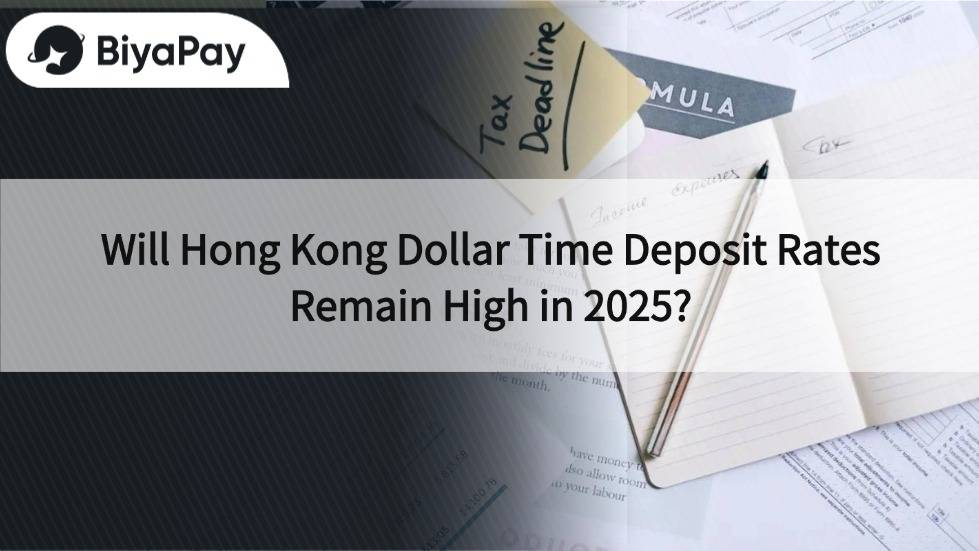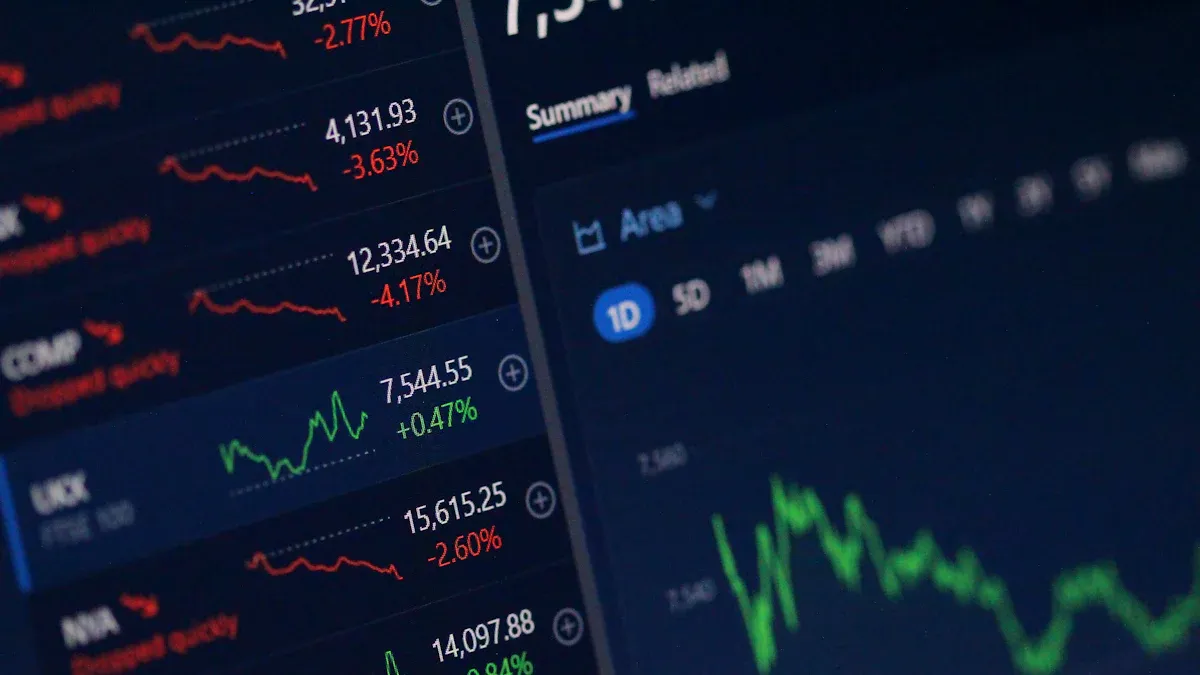- EasyCard
- Trade
- Help
- Announcement
- Academy
- SWIFT Code
- Iban Number
- Referral
- Customer Service
- Blog
- Creator
Will Hong Kong Dollar Time Deposit Rates Remain High in 2025?

Image Source: unsplash
In 2025, Hong Kong dollar (HKD) time deposit rates exhibit noticeable fluctuations. From January to May, the 1-month HKD interbank offered rate (HIBOR) plummeted to 0.545%, with short-term time deposit rates falling below 1%, indicating a significant decline in rates during certain months. However, many Hong Kong banks continue to maintain high-interest promotions, attracting investors to compare different products. The market expects the U.S. Federal Reserve to cut rates by an additional 50 basis points in the second half of the year, suggesting potential for further rate adjustments in the future. Investors need to closely monitor the latest rates and terms offered by banks.
Key Points
- In 2025, HKD time deposit rates show significant fluctuations, primarily influenced by U.S. Federal Reserve interest rate policies and capital flows in Hong Kong banks.
- Many Hong Kong banks offer high-interest time deposit promotions, with rates ranging from 6% to 10%. Investors can compare products to select suitable options.
- Investors should diversify deposit tenors and banks, flexibly adjusting capital allocation to mitigate risks from rate fluctuations.
- Closely monitoring U.S. economic data and Federal Reserve policy changes helps anticipate rate trends and adjust investment strategies promptly.
- Carefully reviewing bank promotion terms to avoid overlooking details and maintaining liquidity to address unexpected market events is essential.
Federal Reserve Policy Impact

Image Source: unsplash
U.S. Dollar Interest Rate Trends
The U.S. Federal Reserve’s interest rate policies have long dominated global financial markets. As the international reserve currency, the U.S. dollar accounts for 57.02% of global central bank reserves, according to the International Monetary Fund (IMF) data from Q4 2019. This proportion far exceeds the euro’s 19.24%. U.S. government policies on tax cuts, deregulation, and tariffs have strengthened the dollar and pushed up U.S. Treasury yields.
U.S. interest rate cycles typically see a bear market every decade, with bull markets lasting six to seven years. When the Fed raises rates, it often triggers crises in emerging markets, such as the 1997 Asian financial crisis and the 2015 emerging market volatility. During economic crises, like the 2001 dot-com bubble burst and the 2020 COVID-19 pandemic, the dollar strengthens due to safe-haven demand.
In November 2022, the yield curve inversion between 10-year and 3-month U.S. Treasuries emerged, often a precursor to economic recession. The U.S. Manufacturing Purchasing Managers’ Index (ISM) declined, and retail sales annual growth dropped from 2.9% to 1.6%, signaling weakening consumer momentum. Small businesses scaled back hiring plans, suggesting potential rises in unemployment. These data reflect slowing U.S. economic growth, prompting the Fed to adjust its rate policies. In 2025, markets widely expect U.S. rates to have peaked, with gradual rate cuts anticipated.
HKD Time Deposit Rate Linkage
The HKD is pegged to the USD, so Federal Reserve policies directly impact HKD time deposit rates. When the U.S. raises rates, Hong Kong banks typically follow suit to maintain liquidity, increasing HKD time deposit rates. Conversely, when the U.S. cuts rates, HKD rates face downward pressure.
In 2025, signs that U.S. rates have peaked are evident, with markets expecting a 50-basis-point rate cut by the Fed. Although HKD time deposit rates have declined in some months, intense competition among Hong Kong banks has led some to offer high-interest time deposit promotions to attract capital inflows.
Investors should closely monitor U.S. economic data and Fed policy developments, as these directly influence HKD time deposit rate trends. If the U.S. economy slows further and the Fed accelerates rate cuts, HKD rates may face additional downward pressure, requiring investors to plan their capital strategies early.
Bank Liquidity and Competition
Capital Liquidity
In 2025, Hong Kong banks maintain ample liquidity. Strong interbank liquidity provides banks with more flexibility to adjust time deposit rates. When capital flows into the Hong Kong market, banks actively attract deposits by offering high-interest products.
Some banks opt to shorten time deposit tenors to attract short-term funds. This strategy allows banks to flexibly manage capital in response to market changes.
Investors should note that changes in liquidity directly affect time deposit rates. When market liquidity is abundant, banks often raise rates to compete for deposits.
High-Interest Promotions
In 2025, several Hong Kong banks launch high-interest time deposit promotions, with some rates reaching 6–10%. There are notable differences in rates, deposit thresholds, and tenors among banks. The table below compares time deposit promotions from major banks:
| Bank Name | 1-Month Rate (Annualized) | 3-Month Rate (Annualized) | Minimum Deposit (USD) | Key Conditions |
|---|---|---|---|---|
| Hang Seng Bank | 6.2% | 5.8% | 10,000 | New funds, online application |
| Fubon Bank | 7.0% | 6.5% | 5,000 | Designated clients |
| Small/Medium Banks | 8.5% | 7.2% | 2,000 | New clients only |
Some smaller banks offer higher rates and lower deposit thresholds to attract new clients. Larger banks emphasize stability and service quality, with slightly lower rates but more flexible terms.
Investors can select suitable banks and products based on their capital size and liquidity needs. It’s recommended to regularly compare the latest promotions from different banks to stay informed about market trends and maximize deposit returns.
Economy and Inflation
Inflation Trends
In 2025, inflation remains high in Hong Kong and globally. The U.S. Federal Reserve raised the federal funds rate target range to 5.25%–5.5% multiple times in 2024 to curb inflationary pressures. Major Hong Kong banks, such as HSBC and Standard Chartered, followed by raising prime rates and initiating share buyback programs to enhance shareholder value. The Hong Kong Interbank Offered Rate (HIBOR) fluctuated with rising global rates, providing banks room to increase time deposit rates.
Rising inflation has prompted many central banks to sharply raise rates, and banks have increased deposit rates to attract savers. Although short-term rates are rising, real rates (after adjusting for inflation) may remain negative, affecting savers’ actual returns. Inflation and central bank policies directly drive adjustments in bank time deposit rates, and investors need to closely monitor inflation data and policy changes.
Economic Growth
In 2024, the U.S. economy performed strongly, with the S&P 500 rising for five consecutive quarters and U.S. 10-year Treasury yields continuing to climb. The Fed signaled a hawkish stance at year-end, reducing expectations for 2025 rate cuts, with only a 50-basis-point cut anticipated. This reflects robust economic data, with central bank rate policies trending toward stabilization, easing downward pressure on time deposit rates.
Hong Kong’s banking sector composite rates remained high in early 2025, with HIBOR showing significant fluctuations. Several banks launched high-yield USD time deposit programs, with rates ranging from 3.28% to 6%. Rising USD rates and exchange rate volatility are key factors influencing time deposit rates. Investors should monitor economic growth data and market expectations, flexibly adjusting capital allocation.
HKD Time Deposit Rate Trends

Image Source: unsplash
Rate Fluctuations
In 2025, HKD time deposit rates exhibit significant fluctuations. At the start of the year, the Hong Kong Interbank Offered Rate (HIBOR) dropped sharply, with 1-month HIBOR falling to 0.545%. This led to declines in short-term HKD time deposit rates, with some banks’ 1-month rates dipping below 1%.
However, abundant market liquidity has enabled some Hong Kong banks to maintain high-interest time deposit promotions to attract new funds. Investors can find short-term time deposit rates of 6–10% at various banks. This reflects intense competition among banks and flexible capital flows.
Experts note that the HIBOR decline is mainly driven by expectations of U.S. rate cuts. When markets anticipate Fed rate reductions, Hong Kong’s funding costs decrease, prompting banks to lower HKD time deposit rates.
However, in certain months, short-term rates may rise due to increased funding demand. For example, during quarter-end or large IPO periods, banks’ funding needs grow, temporarily boosting short-term HKD time deposit rates.
Investors should closely monitor HIBOR trends, as these directly affect HKD time deposit rate levels.
Market Forecasts
Markets widely expect HKD time deposit rates to remain volatile in the second half of 2025. Many economists believe the U.S. Federal Reserve may cut rates by an additional 50 basis points, further reducing Hong Kong’s funding costs and exerting downward pressure on HKD time deposit rates.
However, competition among Hong Kong banks remains fierce. Some smaller banks may continue offering above-average time deposit rates to attract new funds.
The table below forecasts 2025 HKD time deposit rate trends for major Hong Kong banks:
| Bank Name | 1-Month Time Deposit Rate (Annualized) | 3-Month Time Deposit Rate (Annualized) | 6-Month Time Deposit Rate (Annualized) |
|---|---|---|---|
| Hang Seng Bank | 6.2% | 5.8% | 5.5% |
| Fubon Bank | 7.0% | 6.5% | 6.0% |
| Small/Medium Banks | 8.5% | 7.2% | 6.8% |
Note: The above rates are for reference only, as actual rates will vary based on market liquidity, bank policies, and U.S. rate changes.
Experts caution that HKD time deposit rates may be influenced by the following factors:
- The pace of U.S. Federal Reserve rate cuts
- Capital inflows or outflows in Hong Kong
- Competitive strategies among banks
- Global economic and inflation changes
Investors should regularly compare time deposit rates from different banks and flexibly adjust deposit strategies. If unexpected events occur, such as large-scale corporate fundraising or global financial market volatility, HKD time deposit rates may temporarily rise.
Investors are advised to closely follow market news, seize high-interest opportunities, and diversify deposit tenors to mitigate risks from rate fluctuations.
Investment Recommendations
Timing for Locking in Time Deposits
When facing HKD time deposit rate fluctuations in 2025, investors should carefully choose the timing to lock in time deposits. When high-interest promotions emerge, especially from smaller Hong Kong banks offering 6–10% short-term rates, investors can consider locking in portions of their funds in batches. This approach captures short-term high-interest opportunities while preserving some liquidity.
Historical data shows that low-volatility strategies perform steadily in most market environments, effectively mitigating downside risks. Short- to medium-term investment-grade bonds, with lower interest rate risk and returns comparable to long-term products, are suitable for allocation during uncertain rate environments.
Experts recommend that investors closely monitor U.S. Federal Reserve policies, the latest rates from Hong Kong banks, and market liquidity, flexibly adjusting time deposit tenors to avoid locking all funds into long-term deposits at once.
Diversification Strategy
Diversifying deposit tenors and product types helps mitigate risks from rate fluctuations. Investors can allocate funds across different time deposit tenors, such as 1-month, 3-month, and 6-month deposits, and select high-interest products from multiple Hong Kong banks. This strategy allows timely reallocation of maturing funds to capture new high-interest promotions when rates rise.
- Multi-asset allocation combined with dividend income sources, particularly in Asian markets, can cushion downturn impacts.
- Bond allocations favoring short- to medium-term high-quality bonds and Asian currency bonds (USD hedged) leverage yield spreads to enhance portfolio yields.
- Strategic flexibility, responding quickly to economic data and policy changes, reduces risks from long-term U.S. Treasuries.
Investors can refer to the table below to plan a diversification strategy:
| Deposit Tenor | Suggested Proportion | Key Advantages |
|---|---|---|
| 1-Month | 30% | Flexible adjustments for sudden rate changes |
| 3-Month | 40% | Balances returns and liquidity |
| 6-Month | 30% | Locks in higher rates, boosts returns |
Risk Management
While HKD time deposit rates are attractive, investors must prioritize risk management. Bank promotion terms often change, and some high-interest products have thresholds for new funds or new clients. Investors should carefully review terms to avoid overlooking details that could affect actual returns.
Historical experience shows that tactically flexible strategies effectively address sharp market declines. Combining expert judgment with rigorous data processes and stress testing enhances portfolio resilience.
Investors should periodically review asset allocations, adjust strategies based on market changes, and reserve some funds for liquidity. During large IPOs or rising funding demand, avoid over-concentration in a single product or bank.
In summary, investors in 2025 should flexibly employ diversification strategies, closely monitor market dynamics, and strengthen risk management to achieve stable returns amid HKD time deposit rate fluctuations.
In 2025, despite fluctuations, HKD time deposit high-interest promotions persist in Hong Kong banks. Investors should adjust deposit strategies based on market changes to diversify risks.
- Data from the Hong Kong Monetary Authority shows that total foreign exchange fund assets reached HK$2.2279 trillion in June 2023, with HKD deposit demand rising by 1.7%.
- Low interbank offered rates help reduce borrowing costs, influencing time deposit rate trends.
Investors should closely follow the latest bank promotions and market information, managing finances prudently.
FAQ
Why do HKD time deposit rates fluctuate?
HKD time deposit rates are influenced by U.S. Federal Reserve policies, Hong Kong bank liquidity, and market competition. Rates tend to fall when the U.S. cuts rates or capital flows into Hong Kong.
Which Hong Kong banks offer higher time deposit rates?
| Bank Name | 1-Month Rate (Annualized) |
|---|---|
| Hang Seng Bank | 6.2% |
| Fubon Bank | 7.0% |
| Small/Medium Banks | 8.5% |
Data is based on 2025 market conditions; actual rates may vary.
What are the risks of investing in HKD time deposits?
- Falling rates reduce returns
- Changing bank promotion terms
- Limited liquidity
Investors should diversify deposit tenors and regularly monitor market conditions.
How do HKD and USD time deposits differ?
HKD time deposit rates are influenced by Hong Kong markets and Fed policies. USD time deposits are affected by USD rates and exchange rate volatility. Investors should consider exchange rate risks.
When is it suitable to lock in long-term time deposits?
When Hong Kong banks offer high-interest promotions or markets expect rates to fall, investors can consider locking in longer tenors. Batch entry is recommended to reduce risks.
HKD fixed deposit rates in 2025 fluctuate, with 6-10% offers but uncertainties from Fed rate cuts and HIBOR declines. BiyaPay empowers flexible investing, enabling US and Hong Kong stock investments without extra overseas accounts—start now at BiyaPay! With transfer fees as low as 0.5% and coverage across 190+ countries, it meets global funding needs. Real-time exchange rate queries enhance USD-HKD tracking, complementing economic calendar monitoring.
Its 5.48% annualized yield wealth product offers flexible withdrawals to navigate volatility. Regulated internationally, it ensures secure transactions. Visit BiyaPay today to optimize your investment strategy!
*This article is provided for general information purposes and does not constitute legal, tax or other professional advice from BiyaPay or its subsidiaries and its affiliates, and it is not intended as a substitute for obtaining advice from a financial advisor or any other professional.
We make no representations, warranties or warranties, express or implied, as to the accuracy, completeness or timeliness of the contents of this publication.




Contact Us
Company and Team
BiyaPay Products
Customer Services
is a broker-dealer registered with the U.S. Securities and Exchange Commission (SEC) (No.: 802-127417), member of the Financial Industry Regulatory Authority (FINRA) (CRD: 325027), member of the Securities Investor Protection Corporation (SIPC), and regulated by FINRA and SEC.
registered with the US Financial Crimes Enforcement Network (FinCEN), as a Money Services Business (MSB), registration number: 31000218637349, and regulated by FinCEN.
registered as Financial Service Provider (FSP number: FSP1007221) in New Zealand, and is a member of the Financial Dispute Resolution Scheme, a New Zealand independent dispute resolution service provider.




















